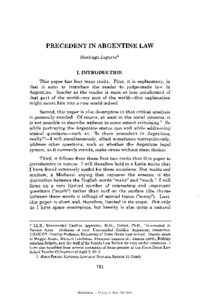Por favor, use este identificador para citar o enlazar este ítem:
https://repositorio.uca.edu.ar/handle/123456789/10418| Campo DC | Valor | Lengua/Idioma |
|---|---|---|
| dc.contributor.author | Legarre, Santiago | es |
| dc.date.accessioned | 2020-07-27T22:47:44Z | - |
| dc.date.available | 2020-07-27T22:47:44Z | - |
| dc.date.issued | 2011 | - |
| dc.identifier.citation | Legarre, S. Precedent in Argentine law [en línea]. Loyola Law Review. 2011, 57. Disponible en: https://repositorio.uca.edu.ar/handle/123456789/10418 | es |
| dc.identifier.uri | https://repositorio.uca.edu.ar/handle/123456789/10418 | - |
| dc.description.abstract | Introduction: This paper has four main traits. First, it is explanatory, in that it aims to introduce the reader to judge-made law in Argentina. Insofar as the reader is more or less uninformed of that part of the world-my part of the world-this explanation might escort him into a new world indeed. Second, this paper is also descriptive in that critical analysis is generally avoided. Of course, at least in the social sciences, it is not possible to describe without to some extent criticizing.' So while portraying the Argentine status quo and while addressing topical questions-such as, "Is there precedent in Argentina, really?"-I will simultaneously, albeit sometimes surreptitiously, address other questions, such as whether the Argentine legal system, as it currently stands, make sense without stare decisis. Third, it follows from these first two traits that this paper is introductory in nature. I will therefore hold to a Latin motto that I have found extremely useful for these occasions: Non multa sed multum, a Medieval saying that captures the essence of the distinction between the English words "many" and "much." I will focus on a very limited number of interesting and important questions ("much") rather than surf on the surface (the rhyme between these words is telling) of myriad topics ("many"). Last, this paper is short and, therefore, limited in its scope. Not only do I have space constraints, but brevity is also quite a natural consequence of the first three traits that I have identified.2 The theme of the Third International Congress of the World Society of Mixed Jurisdiction, where this paper was originally presented, was "Methodology and Innovation in Mixed Legal Systems." Playing with familiar words for all of us at the Congress, I shall say that even if there does not seem to be much innovation in my methodology, this paper may nevertheless produce fruitful results. For a person who simply ignores, or ignores by and large, what is going on in Argentina with regard to this topic, this paper may hopefully entail some innovation. And, if the methodology is sound, that reader will also be able to understand the extent to which the Argentine Republic, although traditionally considered a civil law domain, has relevant elements in common with a mixed jurisdiction. | es |
| dc.format | application/pdf | es |
| dc.language.iso | eng | es |
| dc.publisher | Loyola University New Orleans College of Law | es |
| dc.rights | Acceso abierto | * |
| dc.rights.uri | http://creativecommons.org/licenses/by-nc-sa/4.0/ | * |
| dc.source | Loyola Law Review. 2011, 57 | es |
| dc.subject | PRECEDENTE | es |
| dc.subject | JUECES | es |
| dc.subject | STARE DECICIS | es |
| dc.title | Precedent in Argentine law | es |
| dc.type | Artículo | es |
| uca.disciplina | DERECHO | es |
| uca.issnrd | 1 | es |
| uca.affiliation | Fil: Legarre, Santiago. Pontificia Universidad Católica Argentina. Facultad de Derecho; Argentina | es |
| uca.version | publishedVersion | es |
| item.fulltext | With Fulltext | - |
| item.grantfulltext | open | - |
| item.languageiso639-1 | en | - |
| crisitem.author.dept | Facultad de Derecho | - |
| crisitem.author.dept | Programa IUS | - |
| crisitem.author.dept | Consejo Nacional de Investigaciones Científicas y Técnicas | - |
| crisitem.author.orcid | 0000-0002-7348-9607 | - |
| crisitem.author.parentorg | Pontificia Universidad Católica Argentina | - |
| crisitem.author.parentorg | Facultad de Derecho | - |
| Aparece en las colecciones: | Artículos | |
Ficheros en este ítem:
| Fichero | Descripción | Tamaño | Formato | |
|---|---|---|---|---|
| precedent-argentine-law-legarre.pdf | 630,66 kB | Adobe PDF |  Visualizar/Abrir |
Visualizaciones de página(s)
89
comprobado en 30-abr-2024
Descarga(s)
169
comprobado en 30-abr-2024
Google ScholarTM
Ver en Google Scholar
Este ítem está sujeto a una Licencia Creative Commons

